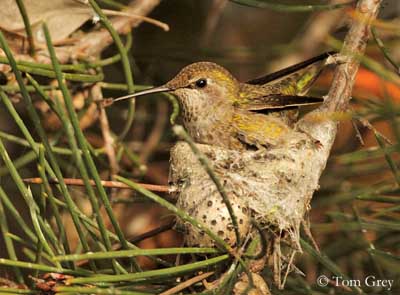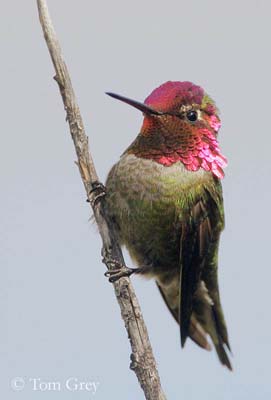
Anna’s Hummingbird
Calypte anna
Apodiforme Order – Trochilidae Family
BIOMETRICS:
Length: 10 cm; Wingspan: 12 cm; Weight: 3-6 g
LONGEVITY: up to 8 years
DESCRIPTION:

Anna’s Hummingbird male has deep rose red head and throat, with small white spot behind eyes. Colour extends on the sides of the neck. Upperparts are bronze green with iridescences.
Underparts are greyish white. We can see varied green washes on the flanks. Wings and tail feathers are dark. Male is slightly larger than female.
Bill is long and blackish. Eyes are black. Legs and feet are blackish.
Female’s throat shows red feathers, but none on crown. Tail feathers have white tips.
Juvenile resembles female, but it lacks red feathers on throat.
Immature usually shows some red feathers on crown and throat.
VOICE: SOUNDS BY XENO-CANTO
Anna’s Hummingbird’s call is a sharp “chick”. When male chases an intruder, it utters a rapid dry rattling.
Male’s song is a jumble of high squeaks and raspy notes.
HABITAT:
Anna’s Hummingbird lives in open woods, gardens and suburban areas. It is abundant in coastal lowlands in winter and mountains in summer. It is a separation between males and females. Males live in open habitats and females live in trees during breeding season.
RANGE:
Anna’s Hummingbird breeds on Pacific Coast, from southern British Columbia to Mexico.
It winters from southern Alaska to Northwest Mexico, and west Texas.
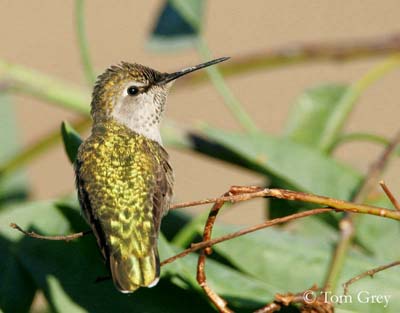
BEHAVIOUR:
To feed, Anna’s Hummingbird hovers above flowers to suck nectar, and in front of sap wells to laps the tree sap. It catches insects in flight, plucks them on the foliage by hover-gleaning, and catches spiders from their webs, and trapped insects in these webs.
Anna’s Hummingbird has long and narrow bill, and its body is adapted to hover over flowers. It has a long tongue which inserts into the flowers, to suck the nectar. It is most attracted by long and tubular flowers with bright colours.
Anna’s Hummingbird is not a gregarious bird. It is very territorial and chases any intruder that enters their territory. It is a diurnal bird. It may enter in hypothermic torpor during the cold nights, to save its energy. Rapid motion of flights causes them to expend most of their energy in flight, and they can consume half of their body weight in food per day.
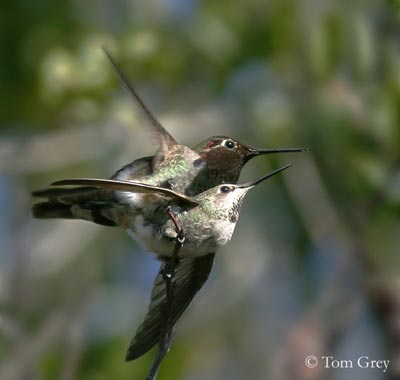
Courtship display of Anna’s Hummingbird is spectacular. Male flies to 20-40 metres high. First, it hovers on 2 to 4 metres in front of female, and climbs in a waving motion straight up. Then, it dives down in an almost vertical dive, and it ends with an explosive “squeak”, just half a metre of the female. It makes a circular arc back to the point where it started. When the weather is sunny, Anna’s Hummingbird’s dive is oriented to reflect the sun on its iridescent throat and crown.
Breeding season begins in December and lasts until May or June. Males arrive first, and females, few weeks later, establishing separate territories.
When a predator attacks the nest, female mobs it. She hovers in front of it, with rapid wing beats, and attacking on the head and back.
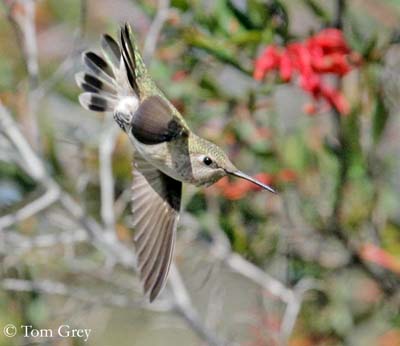
FLIGHT:
Anna’s Hummingbird hovers to feed, catches insects on the wing, and performs a spectacular flight display, rising high and diving in front of female. Its wings can beat from 22 to 75 times per second.
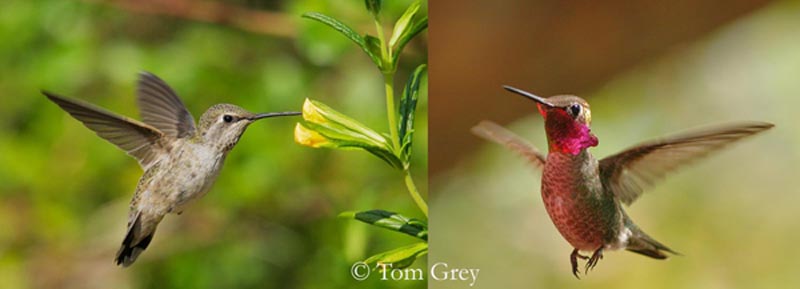
REPRODUCTION:
Anna’s Hummingbird’s nest is made with bark fibres, leaves, lichens, in an attempt to hide it. All materials are bound together with spider webs. It is a small deep cup, lined with soft materials, plants, feathers or hair.
Female lays 2 white eggs. Incubation lasts about 14 to 19 days, by female. Chicks hatch altricial. They open their eyes at 5 days, and they are covered with down at 6.
They remain in the nest 18 to 23 days. After fledging, female takes care of them for few days more and they are independent one or two weeks later.
Young rapidly develop territorial behaviour, establishing their own feeding areas, shortly after fledging. They reach their sexual maturity at one year.
This species produces two clutches per year.
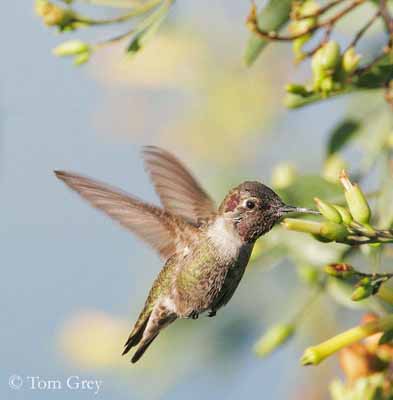
DIET:
Anna’s Hummingbird feeds on nectar flower, tree sap, very small insects and spiders.
PROTECTION / THREATS / STATUS:
Anna’s Hummingbird has some predators such as Scrub Jays and American kestrels.
Populations are increasing since 1950. They adapt very well to suburban areas, and visit flowers and feeders of urban parks and gardens.
Fr: Colibri d’Anna
All : Annakolibri
Esp : Colibrí de Ana
Ital : Colibri di Anna
Nd : Anna-kolibrie
Sd : Annas Kolibri
Photos de Tom Grey
Son site :
Tom Grey's Bird Pictures
Texte de Nicole Bouglouan
Sources :
HANDBOOK OF THE BIRDS OF THE WORLD Vol 5 by Josep del Hoyo-Andrew Elliott-Jordi Sargatal - Lynx Edicions - ISBN: 8487334253
A GUIDE TO THE BIRDS OF MEXICO AND NORTHERN CENTRAL AMERICA by Steve N. G. Howell, Sophie Webb - Oxford University Press - ISBN: 0198540124
All About Birds (Cornell Lab of Ornithology)
Wikipedia (Wikipedia, The Free Encyclopedia)
What Bird-The ultimate Bird Guide (Mitchell Waite)
Bird Web (Seattle Audubon Society)
